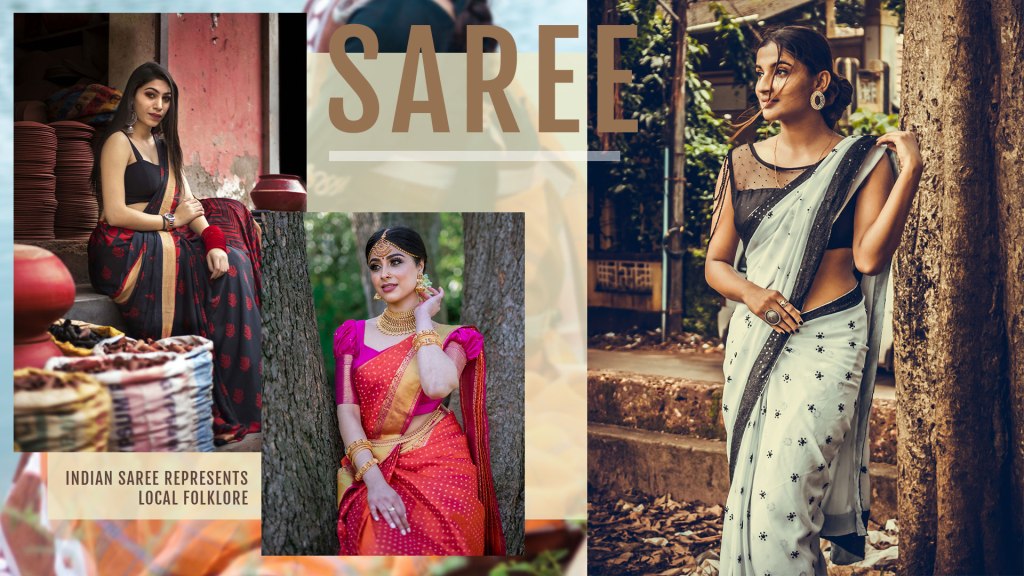The saree is a representation of our country’s cultures and traditions. The beauty of a saree is unrivalled, which is why so many people adore it.

Unique types of Sarees may be found across the length and breadth of the country, making them an everlasting ethnic piece of clothing. The trendy 9 yards of drape can be dressed and modelled in a variety of ways, depending on the different types of sarees available in India.
Our rich heritage has given us different dialects, delicacies, and even Saree variants! One saree at a time, we’ll take you on a tour of the country!
Let’s look at the numerous sorts of sarees and saree names that will have you raiding your mother’s closet and trying on
Indian sarees come in a variety of styles.
1. Kanjeevaram
Kanjeevaram Saree has a beautiful aura due to its vibrant hues, majestic borders, and sumptuous silk. Tamil Nadu is where it all began.
Kanjeevaram is a traditional bridal sari that has become popular in India for special occasions. Sally, made of pure mulberry silk, exudes grace and refinement. To boost its appearance, Saree has a striking gold tinge.
2. Pochampally Saree from Telangana
Hailing from Telangana, the Pochampally Sarees are designed with nuanced motifs and geometric patterns.
These sarees are made with the special Ikat style of dyeing used to get the effect of distinct “Chowra” patterns which look like waves of diffused squares and diamonds. Weaved with either cotton or silk, these sarees are very artistic in nature.
3. Nauvari
Nauvari is a traditional Indian sari from the West Coast. The sari’s name is derived from the length of the sari, which is 9 metres.
The “Kashta” drape design, which hides the sari border behind it, is especially peculiar to Nauvari.
4. Bandhani
Gujarati saris are known for their tie dyes and colours Bandhani. The Bandhani Sarees are available in a wide range of colours and patterns, yet they all have the same ancient principles. It brings the bride good luck and a bright future. The procedure for creating
Hand dyeing is used in the production of Bandani Sally. Bandhanis are a delectable ethnic-style sari that conjures up images of Gujarat and Rajasthan culture.
5. West Bengali Tant Saree
The Tant saree stands out among all the numerous types of sarees in India. This red and white saree from Bengal epitomises elegance.
Every Bengali woman’s outfit must include a saree. Tant is made of a breathable material that allows it to be worn in hot conditions.
6. Varanasi-based Banarasi saree
The Banarsi saree is one of the most popular among the several styles of sarees produced by various states. These silk sarees are famous for their patterns and motifs all the way from Varanasi.
Varanasi saris were originally manufactured just for the royals and were woven with actual gold and silver threads. Many varieties of the Varanasi sari now make up some of India’s best saris, yet their grace has not yet been lost.
7. Chikankari saree
These beautiful lakhnavi sarees are stunning and have a beautiful intricate designs. Featuring profuse embroidery in muted colours, these sarees can be worn at any time and for any occasion. Turn your head to the exquisite Chikankari. Orissa’s Bonkai Sally Orissa produces a different sort of sari. Hand-woven Bongkai is the name of the Indian sari. The pattern on this sari appears to be new, but it is firmly ingrained in the tradition of the state.
8. Bonkau Sarees
Cotton Bomkai Sarees are popular for everyday wear, but silk Bomkai Sarees are luxurious and festive. The saree is infused with mythological designs and carries influence from the past.
9. Madhya Pradesh’s Chanderi
Cotton is used to weave silk with zari, making the cloth light and airy. Sally’s opulent atmosphere is ideal for gatherings and festivals. The sari can be worn in a variety of ways, none of which will detract from Chandeli’s beauty. This curtain’s hand-woven weaving has a delectable texture, and it will draw attention at wedding parties.
10. Muga Saree from Assam
With a glossy sheen and durable silk, the different types of saree available in the market are incredibly versatile. With a natural goldish tint, the saree is a spectacle. This coveted saree is a go-to attire for weddings and other auspicious occasions. One of the costliest silks, Muga’s shine improves with every wash making it timeless.
11. Phulkari Saree From Punjab
Phulkari is the folk embroidery of Punjab resulting in beautiful patterns. Phulkari sarees come in florals, motifs, and even geometrical shapes.
The extensive detailing of the Phulkari saree is crafted through darn stitches on the coarse side of the cotton. Phulkari designs are extremely attractive owing to the vibrant colored cloth that is used.